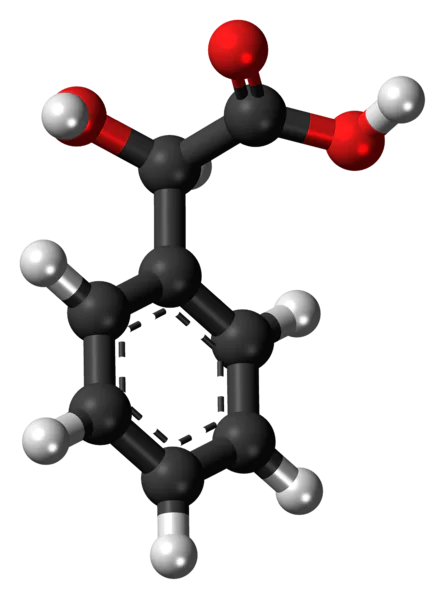Mandelic acid is the new kid on the skincare block, but don’t underestimate its power! This gentle alpha hydroxy acid (AHA) is making waves for its ability to brighten, smooth, and clear all complexions, especially those prone to sensitivity.

Image source : wikipedia
Derived from bitter almonds (hence the name!), mandelic acid boasts a unique molecular structure. It’s larger than other AHAs like glycolic acid, meaning it penetrates the skin slower, making it less irritating and ideal for sensitive souls.
Korean Hairstyle Craze: A Guide to Trendy Korean Hairstyles
But what exactly can mandelic acid do for your skin? Buckle up for a dive into its magic:
Benefits of Mandelic Acid:
- Gentle Exfoliation: Say goodbye to dead skin cells and hello to a radiant glow! Mandelic acid gently buffs away the top layer, revealing smoother, fresher skin.
- Acne Buster: Its antibacterial and anti-inflammatory properties help fight breakouts and even fade pesky acne scars.
- Anti-Aging Warrior: Boost collagen production and improve skin elasticity to say sayonara to fine lines and wrinkles.
- Hyperpigmentation Hero: Sunspots and age spots? Mandelic acid fades them like a superhero, evening out your skin tone.
- Friend to All Skin Tones: Unlike some AHAs, mandelic acid is less likely to irritate darker skin tones, making it an inclusive skincare choice.
But wait, there’s more! Mandelic acid also helps:
- Reduce the appearance of enlarged pores
- Minimize the look of uneven texture
- Improve overall skin tone and brightness
Convinced? Here’s how to incorporate mandelic acid into your routine:
- Start slow: Patch test first and introduce products gradually, especially if you have sensitive skin.
- Choose wisely: Look for formulations with mandelic acid concentrations between 5% and 10%.
- Moisturize and protect: Don’t forget to hydrate! Mandelic acid can make your skin more sensitive to the sun, so SPF is your BFF.
What are the risks of using mandelic acid?
While mandelic acid is generally considered gentle and well-tolerated, there are still some potential risks to be aware of:
Irritation: Even though it’s gentler than other AHAs, mandelic acid can still cause irritation, especially for those with very sensitive skin. Symptoms might include redness, dryness, stinging, or burning. Start slowly, patch test, and stop using if you experience any irritation.
Sun sensitivity: Like other AHAs, mandelic acid can make your skin more sensitive to the sun for a few days after use. This increases your risk of sunburn and hyperpigmentation. Always wear sunscreen (SPF 30 or higher) every day, even on cloudy days, while using mandelic acid.
Over-exfoliation: Overusing mandelic acid or combining it with other harsh exfoliants can disrupt your skin’s barrier and lead to dryness, peeling, and inflammation. Start with a low concentration and use it sparingly, especially if your skin is already dry or sensitive.
Interactions with other ingredients: Mandelic acid can interact with some skincare ingredients, causing irritation. Avoid using it with other AHAs, retinol, or benzoyl peroxide unless advised by a dermatologist.
Pregnancy and breastfeeding: There is limited data on the safety of mandelic acid during pregnancy and breastfeeding. It’s best to consult your doctor before using it if you are pregnant or breastfeeding.
Allergic reactions: Although rare, some people may be allergic to mandelic acid or its derivatives. Be aware of any unusual reactions after applying and stop using immediately if you suspect an allergy.
Here are some additional tips for minimizing risks:
- Choose products with lower concentrations of mandelic acid (5-10%) for sensitive skin.
- Introduce mandelic acid gradually into your routine, allowing your skin to adjust.
- If you have any concerns, consult a dermatologist before using mandelic acid.
By following these tips and being mindful of the potential risks, you can enjoy the benefits of mandelic acid for a healthy and radiant complexion. Remember, listening to your skin and using products responsibly is key to achieving your skincare goals safely and effectively.
Mandelic acid FAQs:
- Is mandelic acid better than glycolic acid? It depends! Mandelic acid is gentler, while glycolic acid is more potent. Choose mandelic for sensitive skin, glycolic for stubborn blemishes.
- Can I use mandelic acid with other actives? Proceed with caution. Consult a dermatologist before combining actives like retinol or vitamin C, as they can increase irritation.
- Where can I find mandelic acid products? Look for them in drugstores, beauty stores, and online retailers. Brands like The Ordinary, Paula’s Choice, and Sunday Riley offer mandelic acid serums, masks, and cleansers.
Final Verdict:
Mandelic acid is a gentle yet powerful exfoliant that deserves a spot in your skincare arsenal. Whether you’re battling acne, wrinkles, or dullness, this multifaceted gem can help you achieve your #skingoals. Just remember to patch test, start slow, and protect your skin from the sun. Go forth and glow, mandelic acid friends!